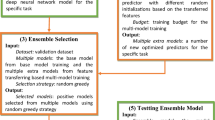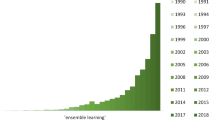Abstract
Addressing uncertainty in Deep Learning (DL) is essential, as it enables the development of models that can make reliable predictions and informed decisions in complex, real-world environments where data may be incomplete or ambiguous. This paper introduces a novel algorithm leveraging Dempster-Shafer Theory (DST) to integrate multiple pre-trained models to form an ensemble capable of providing more reliable and enhanced classifications. The main steps of the proposed method include feature extraction, mass function calculation, fusion, and expected utility calculation. Several experiments have been conducted on CIFAR-10 and CIFAR-100 datasets, demonstrating superior classification accuracy of the proposed DST-based method, achieving improvements of 5.4% and 8.4%, respectively, compared to the best individual pre-trained models. Results highlight the potential of DST as a robust framework for managing uncertainties related to data when applying DL in real-world scenarios.
Access this chapter
Tax calculation will be finalised at checkout
Purchases are for personal use only
Similar content being viewed by others
References
Boulila, W., Ayadi, Z., Farah, I.R.: Sensitivity analysis approach to model epistemic and aleatory imperfection: application to land cover change prediction model. J. Comput. Sci. 23, 58–70 (2017)
Chen, X., et al.: Comprehensive evaluation of dam seepage safety combining deep learning with Dempster-Shafer evidence theory. Measurement 226, 114172 (2024). https://doi.org/10.1016/j.measurement.2024.114172
Dempster, A.P.: A generalization of Bayesian inference. J. Roy. Stat. Soc.: Ser. B (Methodol.) 30(2), 205–232 (1968)
Denœux, T.: Logistic regression, neural networks and Dempster-Shafer theory: a new perspective. Knowl.-Based Syst. 176, 54–67 (2019)
Ferchichi, A., Boulila, W., Farah, I.R.: Propagating aleatory and epistemic uncertainty in land cover change prediction process. Ecol. Inform. 37, 24–37 (2017)
Ferchichi, A., Boulila, W., Farah, I.R.: Reducing uncertainties in land cover change models using sensitivity analysis. Knowl. Inf. Syst. 55, 719–740 (2018)
Fidon, L., et al.: A Dempster-Shafer approach to trustworthy AI with application to fetal brain MRI segmentation. IEEE Trans. Pattern Anal. Mach. Intell., 1–12 (2024). https://doi.org/10.1109/TPAMI.2023.3346330
Griffiths, T.L., Zhu, J.Q., Grant, E., McCoy, R.T.: Bayes in the age of intelligent machines (2023)
Li, M.Y., Grant, E., Griffiths, T.L.: Gaussian process surrogate models for neural networks. In: Uncertainty in Artificial Intelligence, pp. 1241–1252. PMLR (2023)
Luo, H., Zhou, Q., Li, Z., Deng, Y.: Variational quantum linear solver-based combination rules in Dempster-Shafer theory. Inf. Fusion 102, 102070 (2024). https://doi.org/10.1016/j.inffus.2023.102070
Marwah, G.P.K., et al.: An improved machine learning model with hybrid technique in VANET for robust communication. Mathematics 10(21) (2022). https://doi.org/10.3390/math10214030
Peñafiel, S., Baloian, N., Sanson, H., Pino, J.A.: Applying Dempster-Shafer theory for developing a flexible, accurate and interpretable classifier. Expert Syst. Appl. 148, 113262 (2020)
Qiu, W., Ma, Y., Chen, X., Yu, H., Chen, L.: Hybrid intrusion detection system based on Dempster-Shafer evidence theory. Comput. Secur. 117, 102709 (2022)
Shafer, G.: Dempster-Shafer theory. Encyclopedia Artif. Intell. 1, 330–331 (1992)
Tian, Z., et al.: Deep learning and Dempster-Shafer theory based insider threat detection. Mobile Netw. Appl., 1–10 (2020)
Tong, Z., Xu, P., Denoeux, T.: An evidential classifier based on Dempster-Shafer theory and deep learning. Neurocomputing 450, 275–293 (2021)
Tong, Z., Xu, P., Denœux, T.: An evidential classifier based on Dempster-Shafer theory and deep learning. Neurocomputing 450, 275–293 (2021). https://doi.org/10.1016/j.neucom.2021.03.066
Varone, G., et al.: Finger pinching and imagination classification: a fusion of CNN architectures for IoMT-enabled BCI applications. Inf. Fusion 101, 102006 (2024)
Xue, P., Fei, L., Ding, W.: A volunteer allocation optimization model in response to major natural disasters based on improved Dempster-Shafer theory. Expert Syst. Appl. 236, 121285 (2024). https://doi.org/10.1016/j.eswa.2023.121285
Yaghoubi, V., Cheng, L., Van Paepegem, W., Kersemans, M.: CNN-DST: ensemble deep learning based on Dempster-Shafer theory for vibration-based fault recognition. Struct. Health Monit. 21(5), 2063–2082 (2022)
Zheng, Y., Li, G., Zhang, W., Li, Y., Wei, B.: Feature selection with ensemble learning based on improved Dempster-Shafer evidence fusion. IEEE Access 7, 9032–9045 (2019)
Zhu, C., Qin, B., Xiao, F., Cao, Z., Pandey, H.M.: A fuzzy preference-based Dempster-Shafer evidence theory for decision fusion. Inf. Sci. 570, 306–322 (2021). https://doi.org/10.1016/j.ins.2021.04.059
Acknowledgment
The authors would like to acknowledge the support of Prince Sultan University for paying the fees of this publication.
Author information
Authors and Affiliations
Corresponding author
Editor information
Editors and Affiliations
Rights and permissions
Copyright information
© 2024 The Author(s), under exclusive license to Springer Nature Switzerland AG
About this paper
Cite this paper
Alzahem, A., Boulila, W., Driss, M., Koubaa, A. (2024). Feature Fusion for Improved Classification: Combining Dempster-Shafer Theory and Multiple CNN Architectures. In: Nguyen, N.T., et al. Computational Collective Intelligence. ICCCI 2024. Lecture Notes in Computer Science(), vol 14811. Springer, Cham. https://doi.org/10.1007/978-3-031-70819-0_22
Download citation
DOI: https://doi.org/10.1007/978-3-031-70819-0_22
Published:
Publisher Name: Springer, Cham
Print ISBN: 978-3-031-70818-3
Online ISBN: 978-3-031-70819-0
eBook Packages: Computer ScienceComputer Science (R0)




